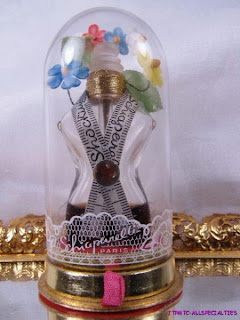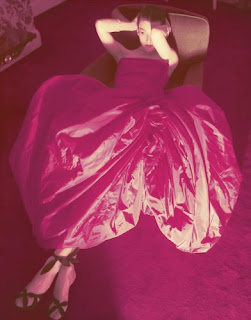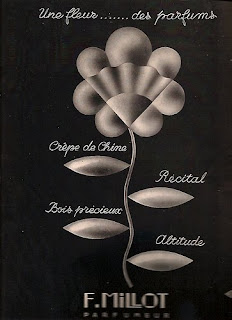(image: thebardot.files.wordpress)
Rarity: 3/10
Cost Range: $60-$270
Perfume Name: Ombre Bleue
Perfumer: Jean Charles Brosseau
Year of release: 1987, discontinued
The above is just my opinion.
It's raining. Again. Nevermind that the almond trees are in full bloom and a week ago people were wearing shorts and pulling huge dandelions from their lawns... Summer seemed to be just around the corner. The warm, nay balmy, weather inspired me to turn to a perfume that I've been pursuing for a while, and for a few of the past and fleeting mild days, I took my chances and wore it once again. But perhaps I jinxed things by reaching for it too early- the skies have gone back to a blacker shade of gray, and I've had to put the bottle back on the shelf for the time being. The scent just doesn't live and breathe for me in the cold, wet waiting of this neo-spring in what is technically still winter... although I await the next warm spell with great anticipation.
(image: jcbrosseau.com)
Do you remember Jean-Charles Brosseau? If you do, chances are you know that he is the name behind the now famous perfume, Ombre Rose. OR was released in 1981 although it was originally developed or 'discovered' several years earlier (in the late 1970s) as an exciting new perfume base. But in the end, it was of such quality that it seemed to form itself into a delicious and complete perfume, a perfection of powdery-woody rose, and the incomparable Ombre Rose was born. In that first blush of its original release, it was very exclusive and expensive, a limited distribution fragrance with restrained advertising. I was in high school at the time so it was somewhat unattainable to me and at the same time, an object of great desire.


(images: JC Brosseau.com)
Now availability of Ombre Rose has soared and after a steady stream of candy colored and named flankers (not to mention, a certain coarseness of some of the later presentations), most of the Jean Charles Brosseau family of scents are packaged and priced comparable to drugstore, rather than higher-end department store, releases. The pure perfume and vintage presentations however remain in higher demand. I have read online in more than one place that Ombre Rose was originally a Caron creation... But not according to JC Brosseau's website which claims it as a creation of his own. OR is classified as a floral - aldehyde and for me, it is quintessentially gorgeous. It's notes are: aldehydes, peach, rosewood, geranium, lily of the valley, ylang-ylang, rose, orris, sandalwood, cedarwood, vetiver, vanilla, honey, iris, musk, cinnamon, tonka bean, heliotrope. I could easily go on about it. To continue my backtrack just a little longer, one of the first things that drew me to Ombre Rose was the gorgeous bottle. It's lacy imprinted art deco design and unusual octagonal shape has undeniable eye-appeal and speaks of an earlier age... because it is a rather direct copy of a well-known vintage Mury Le Narcisse Bleu perfume bottle.

(image: cardmine.co)
(image: aedarsch.cgi.ebay)
(image: flickr, Mury 1946)
(image of JC Brosseau Fleurs D'Ombre Bleue: cortezan)
(image of the original Ombre Bleue: cgi.ebay)
Fast forward 20 years. I am combing through a little local thrift store when I notice a small square shouldered bottle with a pretty, impressed, vaguely art deco floral pattern just like the one above. It was a mini identical to the one shown directly above. It bore no trace of markings and any thoughts of Ombre Rose were far removed from me then. I set the little bottle on my bureau and proceeded to live my life. Then one day, I thoughtlessly dabbed a little of the perfume from the bottle onto my shoulders before setting out to walk my dogs one warm summer day. I'm sure you can guess what happened next... when a most wonderful and exotic, lush odor began to tickle my nose. What was it? I searched around a little only to discover it was me. Or more exactly, the little area on my sun warmed shoulders where the scent had been applied. I was enchanted. A combination of warm and sharp- white flowers among which I can pick out lily of the valley, Tiare and jasmine, mimosa (?), orange blossom and leaves, smooth woods all polished and folded into the purest sweet bee's wax. I rushed home and examined the bottle again hoping to find some marking, anything to give me a hint at the magical contents of the bottle. I noted the impressed pattern in the glass again. It reminded me of something I'd seen before and I knew it would be the key to my finding the identity of the mystery perfume. It was more-or-less a trial and error process, searching my books and references for that same floral patterned glass bottle. I looked, I quit. I looked and gave up again. Then, I happened across an old black spray canister of Ombre Rose cologne- it bore a gold printed pattern that strongly resembled the little bottle and suddenly a light clicked on in my head... The pattern was a neat fit to that on my little glass one and it was then I realized they had to be related. The Ombre Rose connection was correct and without too much trouble I found the exact match to my bottle, in what turned out to be a photograph of JC Brosseau's original Ombre Bleue (1987) perfume. Only problem was by the time I'd found it, it had been discontinued. The prices for the few remaining bottles to be found had soared to what was, back then, way out of my price range for something that had been quite affordable and was only relatively recently deceased. So I treasured my little stash of parfum to the last and continued to open the empty bottle just to inhale deeply of its traces until the little plastic stopper finally pulled apart and wedged part of itself into the neck of the little bottle. This was actually one of my earliest perfume lemming experiences. Life went on of course, but I always kept an eye out for the chance to capture another sample of OB. And a few months ago, it happened. A nice, nearly full bottle of OB appeared on EBay; in the end, it was destined for me since no one even entered a competing bid.

(image of vintage bathing suit 28 at 3.bp.blogspot)
What was it about Ombre Bleue that captured my senses so completely? The notes reveal not so much in the way of novel components. In fact it was familiarity that allowed this particular scent to worm its way into my subconscious and then, my heart. Here is a quote and the notes from Jan Moran: "Ombre Bleue is rich and vibrant, a scent comprised of florals, woods, and amber. Honeysuckle, peach, and plum impart freshness, while rose and jasmine form the classic floral heart. Amber--smooth and sensual--is blended with woods of sandalwood and vetiver. The result is decidedly feminine, expansive and vivacious. " I've found several other sources with slightly different notes. Confusion abounds because very soon after releasing Ombre Bleue, JC Brosseau released possibly the same perfume, in a reformulated version and in a "new" bottle- instead of the square shouldered version, it was reissued (in the reformulated version) in the same octagonal bottle as is used for Ombre Rose, only the juice is blue. It is still in production, called Fleurs D'Ombre Bleue Perfume for Women, with the following fragrance notes: rose, jasmine, vanilla, plum, orange tree, lily of the valley, mimosa, tiare flowers and bees wax. It is funny that if you look on line for reviews of this perfume, or any perfume called Ombre Bleu, you will find one of two things. The reviews either praise the perfume highly as a scent of singular character and quality- or they pan it totally as worthless- watery, weak and thin, and nothing like what they expected from reading earlier reviews and word of mouth. Do I need to tell you that the poor reviews are coming from folks who ran across the reformulated FDOB, based on the great nearly cultish following that the original OB established. What was it about OB that people loved? Well, simply put- it is the scent of summer. But it transcends just any garden variety tropical floral because it mimics the scent of another cult (now well known, if currently out of fashion) classic, Bain de Soleil. Yes, the famous orange tanning gel that, if you are of a certain age, you surely recall...

(image: from pacocamino, originally photobucket)
According to beauty mythology Coco Chanel is credited as the first figure to make the tan fashionable back in 1920. Jumping five years later, a certain Monsieur Antonine of Paris developed a dark tanning product which was predictably called "Bain de Soleil Antoine de Paris" in 1925. The orange paste continued to sell throughout Europe until the 1940's when Lanvin, a New York based fragrance company, introduced it to the United States as [Antoine's] Bain de Soleil. It became sought after here as well, loved for its color, texture and a radiant, exotic scent before a major magazine advertising campaigne made it even more popular. I don't know, but would not be surprised to learn that Lanvin was responsible for adding this touch of fragrance to the oil, which I'm sure was a large part of its lasting success. The smell of Bain de Soleil shimmered and indeed radiated warmth and good feelings so it really isn't a surprise that Brosseau's Ombre Bleue, designed to recall the scent of early French tanning oils strikes such a pleasing chord. I'm only surprised that the original version of Ombre Bleue disappeared so quickly and has now become so rare. I now have the edp formula and even that is a paler version of the pure parfum, which is truly excellent and not to be missed if at all possible, especially for lovers of tropical 'suntan oil' themed scents. Ombre Bleue manages to evoke the sun and exotic beach locations while avoiding totally the stereotypical, dreaded coconut or marine cliches.

(image of a tanned Coco, img.thesun.co_archives)
(image of a vintage 1960s JC Brosseau hat: bigyellowtaxivintage at Esty.com)
By the way, Jean Charles Brosseau began his career as a fashion designer of women's hats in the 1960s or slightly earlier. He created his own label at age 25 and immediately his clients included the most illustrious haute couture creators in France. If you want to search for an even rarer Brosseau perfume than Ombre Bleue, in 1978, Jean-Charles created his first fragrance, cleverly called “BrossEau” that was sold in his shop at the Place des Victoires. I've never even glimpsed it, though it's probably a 7 (or higher!) of 10 on my self-created rareness scale. Do let me know if you've sighted or smelled it!
The Vintage Perfume Vault, where the scent of yesterday's vogue lives.



































